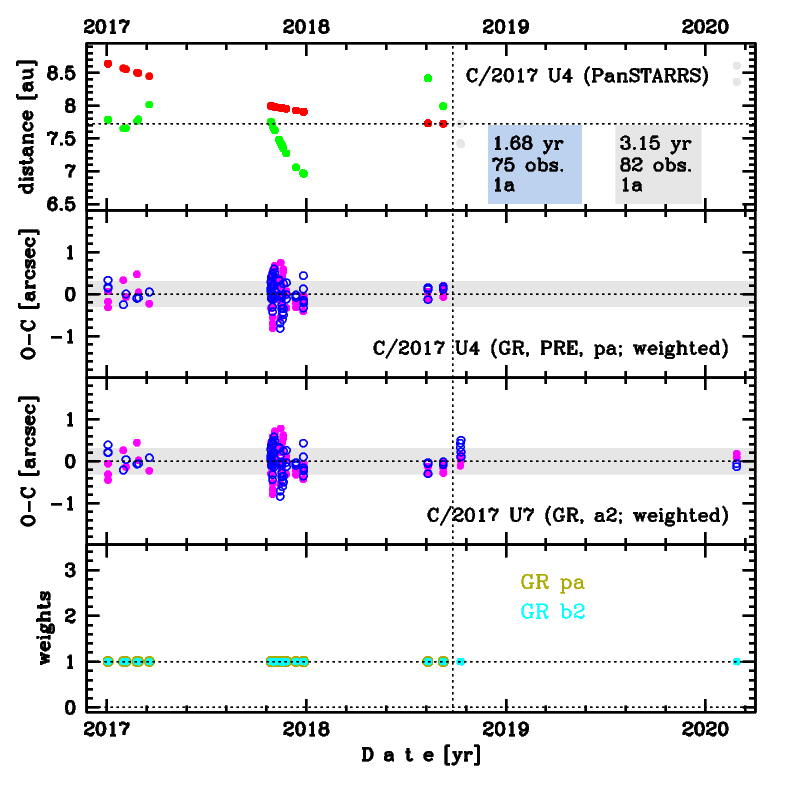C/2017 U4 PANSTARRS
more info
Comet C/2017 U4 was discovered on 27 October 2017 with Pan-STARRS 1 telescope (Haleakala), that is about 11 months before its perihelion passage. Few prediscovery images of this comet were found: taken by the same survey from 2 January 2017.This comet was observed until 26 February 2020.
Comet had its closest approach to the Earth on 11 December 2018 (6.761 au), about 2.5 months after its perihelion passage.
The preferred solution given here is based on data spanning over 3.15 yr in a range of heliocentric distances: 8.64 au – 7.72 au (perihelion) – 8.36 au.
This near-parabolic comet suffers tiny planetary perturbations during its passage through the planetary system (original and future semimajor axes around 9,000 au).
Comet had its closest approach to the Earth on 11 December 2018 (6.761 au), about 2.5 months after its perihelion passage.
The preferred solution given here is based on data spanning over 3.15 yr in a range of heliocentric distances: 8.64 au – 7.72 au (perihelion) – 8.36 au.
This near-parabolic comet suffers tiny planetary perturbations during its passage through the planetary system (original and future semimajor axes around 9,000 au).
| solution description | ||
|---|---|---|
| number of observations | 82 | |
| data interval | 2017 01 02 – 2020 02 26 | |
| data type | perihelion within the observation arc (FULL) | |
| data arc selection | entire data set (STD) | |
| range of heliocentric distances | 8.64 au – 7.72 au (perihelion) – 8.36 au | |
| detectability of NG effects in the comet's motion | NG effects not determinable | |
| type of model of motion | GR - gravitational orbit | |
| data weighting | YES | |
| number of residuals | 153 | |
| RMS [arcseconds] | 0.31 | |
| orbit quality class | 1a | |
| previous orbit statistics, both Galactic and stellar perturbations were taken into account | ||
|---|---|---|
| no. of returning VCs in the swarm | 5001 | * |
| no. of escaping VCs in the swarm | 0 | |
| no. of hyperbolas among escaping VCs in the swarm | 0 | |
| previous reciprocal semi-major axis [10-6 au-1] | 108.32 – 111.65 – 114.98 | |
| previous perihelion distance [au] | 7.7507 – 7.7535 – 7.7565 | |
| previous aphelion distance [103 au] | 17.4 – 17.9 – 18.5 | |
| time interval to previous perihelion [Myr] | 0.81 – 0.847 – 0.886 | |
| percentage of VCs with qprev < 10 | 100 | |

Upper panel: Time distribution of positional observations with corresponding heliocentric (red curve) and geocentric (green curve) distance at which they were taken. The horizontal dotted line shows the perihelion distance for a given comet whereas vertical dotted line — the moment of perihelion passage.
Middle panel(s): O-C diagram for a given solution (sometimes in comparison to another solution available in CODE), where residuals in right ascension are shown using magenta dots and in declination by blue open circles.
Lowest panel: Relative weights for a given data set(s).
Middle panel(s): O-C diagram for a given solution (sometimes in comparison to another solution available in CODE), where residuals in right ascension are shown using magenta dots and in declination by blue open circles.
Lowest panel: Relative weights for a given data set(s).
| previous_g orbit statistics, here only the Galactic tide has been included | ||
|---|---|---|
| no. of returning VCs in the swarm | 5001 | * |
| no. of escaping VCs in the swarm | 0 | |
| no. of hyperbolas among escaping VCs in the swarm | 0 | |
| previous reciprocal semi-major axis [10-6 au-1] | 108.32 – 111.65 – 114.98 | |
| previous perihelion distance [au] | 7.73853 – 7.73912 – 7.73979 | |
| previous aphelion distance [103 au] | 17.4 – 17.9 – 18.5 | |
| time interval to previous perihelion [Myr] | 0.81 – 0.847 – 0.886 | |
| percentage of VCs with qprev < 10 | 100 | |